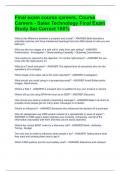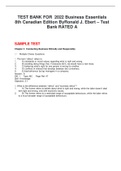Exam (elaborations)
Test Bank For Corporate Finance 12th Edition By Ross / All (Chapter 1-27) Updated Version 2024
- Course
- Institution
- Book
Test Bank for Corporate Finance 12th Edition By Ross / All (Chapter 1-27) Updated Version 2024 Chapter 1 Introduction to Corporate Finance 1) The treasurer and the controller of a corporation generally report to the: A) board of directors. B) chairman of the board. C) chief executive office...
[Show more]












